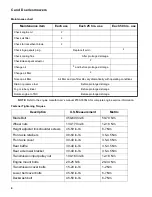
Blade and Belt
7
Blades
The condition of the blades will greatly effect the quality of the cut.
The blades should be sharpened and balanced after every 10 hours of cutting, or when a change in cut quality or
performance is noticable. Inspect the blade every couple hours of use. Blade sharpening needs vary with local condi-
tions. A dull blade tears the grass instead of cutting it. Torn grass blades leaves a rough look and makes the grass
vulnerable to diseases.
Blades need to be examined for damage before sharpening. Blades must be balanced after sharpening to
reduce the vibrations felt from the deck.
Bent blades are a sign of a blade impact. The blades must be replaced and the engine inspected for a bent
crankshaft if a bent blade is found. A bent blade or a bent crankshaft will cause other damage to the mower. A typical
customer complaint would be that parts are vibrating and falling-off the mower. In extreme cases, when the mower is
run with a bent blade or crankshaft, the engine can tear loose from the deck.
Do not attempt to straighten a bent blade or crankshaft. The bent part must be replaced. In the case of the crank-
shaft, solutions include, replacing the crankshaft, replacing the short block, replacing the complete engine, or replac-
ing the mower.
Bent blades and bent crankshafts are seldom warrantable damage.
Blades come in a variety of styles; side discharge, mulching, bagging, combination, there are even de-thatching
blades on the market. The C and D Series mowers come equipped with a 3-in-1 blade from the factory. The outer
part of the leading edge cuts the grass. A wing on the back edge lifts the grass for the next blade and propels clip-
pings toward the bag or side discharge chute if the path to either is open. A stepped-up cutting edge just in-board of
the outer cutting edge mulches clippings as they fall, if the side and/or rear discharge chute(s) are closed and the
mulch plug is in place.
The air flow in the cutting deck is generated by the spinning blade. If the blade is mounted upside down, the air
flow will be reversed pushing the grass down instead of standing up.
NOTE:
Blades that are mounted upside down increase the risk of impact damage.
Running a mower with a bent blade will cause damage to the mower and can create a thrown
object hazard. As soon as damage or vibration is noted, the mower should be taken out of ser-
vice until the problem is repaired.
! CAUTION
! CAUTION
Straightening a bent blade or crankshaft increases the damage to the metal. This can create a
thrown object hazard.
! CAUTION
! CAUTION
An incorrect or improperly mounted blade can create a thrown object hazard.
! CAUTION
! CAUTION
CHAPTER 2: BLADE AND BELT












































